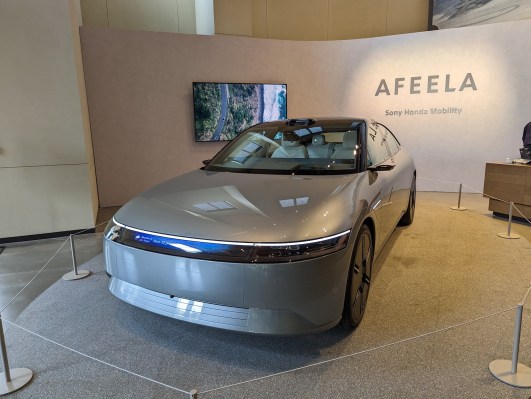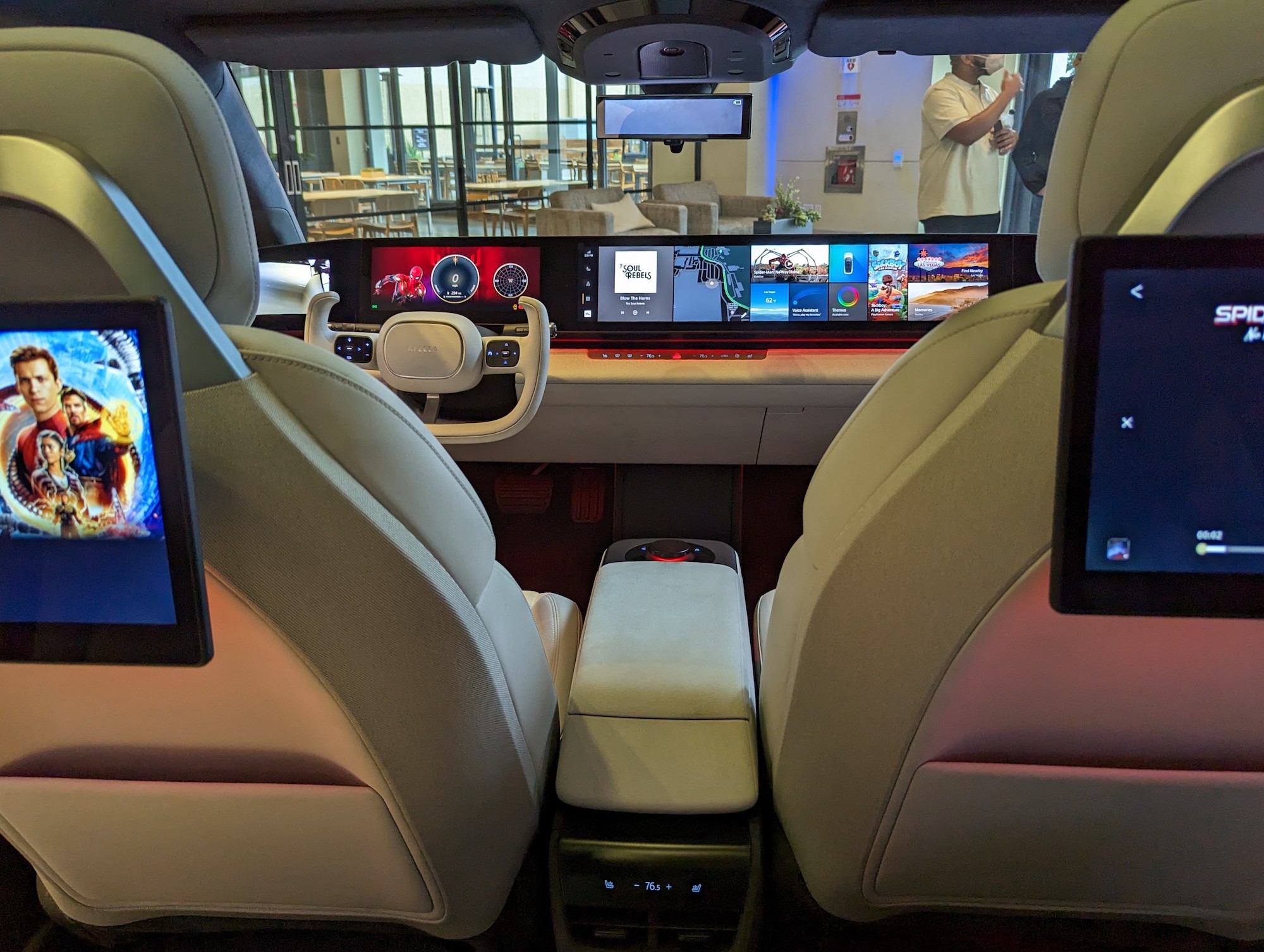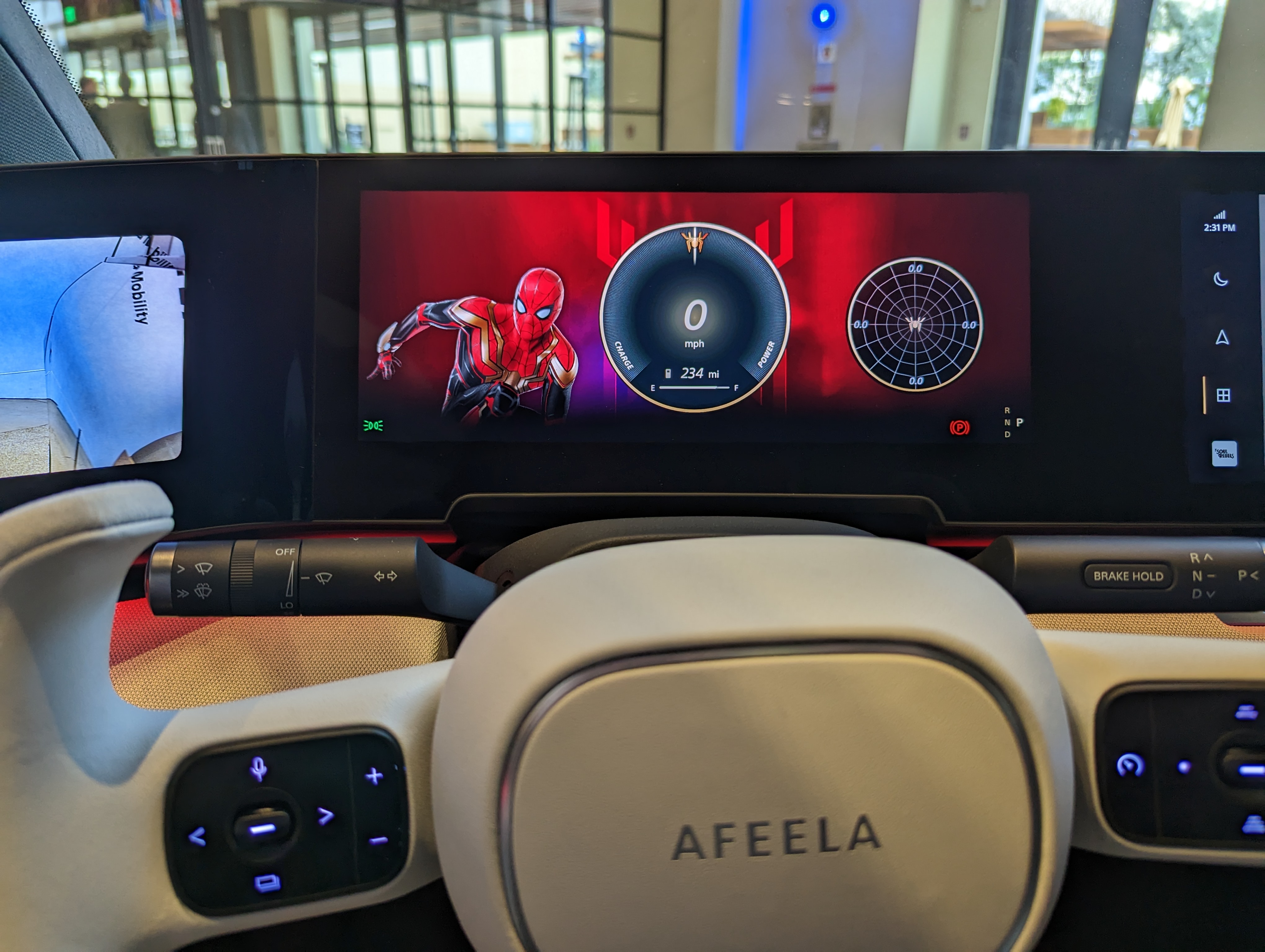If it wasn’t clear earlier this year when Sony and Honda revealed the concept Afeela EV, it is now: This new joint-venture concept car is all about leveraging entertainment.
The company, known as Sony Honda Mobility (SHM) is a joint venture between the Japanese entertainment and tech giant Sony, and the Japanese automaker, Honda. It rolled out a concept vehicle at CES 2023 under the new brand name Afeela. And now, it’s showing off its plans for the interior.
SHM bills Afeela as representing “a new relationship between people and mobility.” From our time inside the cabin of the concept car at the Sony Studio Lot in Culver City, that “new relationship” relies heavily on the whiz-bang of entertainment features.
A movie theater in your car
There are a lot of features in the Afeela that fall into the this-will-never-see-the-light-of-day category. For instance, there are no door handles on the Afeela. Zip. Zero. Ziltch. That makes getting into the vehicle a bit of a conundrum that will likely be fixed with the addition of door handles in the production version.
In theory, the driver or passenger would walk up to the smooth-bodied EV and one of the 45 sensor arrays and cameras positioned both inside and outside of the car would recognize their approach and open the car door. During our demonstration of the concept, however, a Honda planner opened the driver’s side door for us using a smartphone app.
But there are other features — namely the screens and audio system — that are likely headed into the production version.
We climbed in and, upon sitting down in the plush Alcantara-like seats, the yoke-style steering wheel moved closer as if inviting us in, while the light-colored seat slid slightly forward. It was impossible to miss all of the screens that stretched from blocky a-pillar to blocky a-pillar across the base of the windshield.
But the folks at Sony Honda Mobility weren’t content with just interior screens. There were also displays on the car’s front and rear bumpers that constantly cycled through a variety of content, including short animations of the movie Spider-Man, the current time and temperature and sports scores. The upshot? Future owners can turn their Afeela into a rolling billboard.
Back inside the vehicle, there are two smaller screens that support the exterior side camera mirrors. These screens are angled toward the driver at the base of the a-pillars, giving the full experience a sort of wrap-around effect.
While the screen in front of the driver and passenger didn’t appear to come up terribly high, from my seating position, I could not see the hood of the car. There are also two additional passenger entertainment screens in the backseat.
The screens in the front of the interior are panoramic, according to my Sony Honda Mobility guides. That means that there are no actual divisions between the screen in front of the driver, the display in the middle or in front of the passenger. You can easily swipe app blocks around from the passenger to the middle sections of the screen without a stutter or jump.
The screen in front of the driver changed to match the theme of whatever entertainment was being displayed on the passenger side. The standard digital dials for speed, range and even g-forces remained displayed in front of me. The colors and whites on the touchscreens appeared bright and clear, while black looked rich and dark. When I dragged content around on the touchscreen, there was no lag or image ghosting, and most notably, no infuriating fingerprints on the screen.
Underpinning the entertainment systems and all those screens are a number of “high performance” Qualcomm SoC chips and Snapdragon’s “Digital Chassis,” which will support the future conditional Level 3 autonomy that SHM says Afeela will have, according to spokespeople at the event.
The company wouldn’t elaborate further, but it’s safe to assume that when the Afeela comes to market, it will boast a wide array of cutting-edge mobile, lidar, radar and camera sensor tech to support the entertainment and advanced driver assistance system.
It’s not enough to see the content. Sony Honda Mobility wants the driver and passengers to have an immersive sound experience too. The Afeela is equipped with Sony’s 360 Reality Audio system, which uses special sound technology that allows individual sounds in music to be placed in a 360-degree spherical sound field. My hosts cued up Blow the Horns by a group called Soul Rebels, on Tidal, which happens to be one of the streaming services that offers music that’s been recorded with the intention of being enjoyed on Sony’s 360 Reality Audio systems, which by the way is the same system in the Lucid Air.
While the speakers in the concept were fixed, Sony Honda Mobility spokespeople confirmed that they will be adjustable in the future vehicle so that shorter or taller drivers and passengers can adjust their aural experience. The horns were warm and inviting, while the groovable bass-heavy rap seemed to rise up from underneath the seats. That’s because, in the concept Afeela, there are individual speakers in each headrest, as well as speakers beneath the seats that offer a relatively visceral experience when listening to music. The Sony Vision-S, which resembles the Afeela but debuted in 2020, also had the same audio system.
While my hosts opted to use the volume slider overlaid (or the dial that rests in front of the center armrest) on the screen to adjust volume, Afeela will offer some form of gesture control when it comes to market in 2026. For example, you could potentially control things like volume by putting your finger to your lips like you’re shushing a chatty moviegoer, and the music would get lower.
Then there’s the option for movies and gaming. Sony is a major media and entertainment producer, and we got to experience the Afeela on the main studio lot. The Afeela was preloaded with Spider-Man: No Way Home, a Sony production from 2021, and our hosts cued it up toward the end of the movie so we could watch a brief clip.
The colors were clear, bright and crisp even though the scene itself was somewhat dim; the audio matched the quality of the images. While it was playing, the spokesperson slid the screen from in front of his passenger seat to the middle of the screen, and the system didn’t stutter or skip. Users of the infotainment system in the Afeela concept can also opt to show the same video on all the available screens at once or allow each individual passenger to customize their entertainment.
We also checked out the PlayStation integration in the Afeela. The SHM team loaded up the PS4/PS5-compatible game called Sackboy: A Big Adventure and played it briefly using a wireless PSP controller, again demonstrating the seamlessness of the screen at the front of the EV by sliding the game from the middle to the passenger side and back while they played, without an issue. The 3D graphics for all the displays were made using the Unreal Engine by Epic Games, which is the creator of Fortnite, and who SHM says they’re working with to “build new values and concepts for mobility.”
Conditional Level 3 autonomous driving?
If all this entertainment in a moving vehicle sounds like a recipe for disaster, you’re not wrong. That’s why SHM has included what it describes as a “Level 3 automated drive under limited conditions” and “Level 2+ driver assistance” in what it terms “urban driving.”
The spokespeople at the event confirmed that the entertainment features would be blocked off from the driver’s vision in some way (still TBD) while they were driving the vehicle. In other cases, like during limited Level 3 driving, the driver would be permitted to see and interact with the content.
Afeela: A brand new entertainment platform
With all the buzz and the features, it’s clear that the new Sony Honda Mobility company is leaning heavily on the future of car travel as an entertainment extension. We have screens that allow us to consume inordinate amounts of information and media in the palms of our hands, but the one place that our media consumption has been limited is in the car.
Consuming media in a vehicle could become the final frontier for major tech and media players like Sony — and the company appears to recognize that.
Representatives at the event did say that all those games, apps and movies would require a subscription to access, much like Netflix. Plus, it will require solid broadband connectivity and processing power to work as seamlessly as it does in the static concept car. And of course, it will have to have proficient automated driving features that would allow a driver to watch a screen instead of the road ahead.
Sony Honda Mobility spokespeople also said that it plans to focus on digital sales for the future Afeela vehicle, rather than a dealer model. Orders open in 2025 with delivery taking place, starting with North America, sometime in 2026. There’s no word on pricing or deposit details yet.


